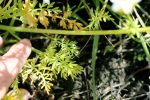I’ve been keeping my eye on the clintonia.
 For much of the year, these perennial lilies simply look like a pile of green, tongue-shaped leaves that sit unchanging on the forest floor. But in the springtime, they reward hikers with a dense cluster of brilliantly pink flowers atop a leafless stalk. There are masses of them along the Steep Ravine trail; when I was there a week ago the flowers looked just about ready to bloom–they are sure to be a lovely sight when they do. Later in the season, the flowers will be replaced by glossy blue-black berries that look like a stylized starburst, exploding from a single point on the end of slim pedicels.
For much of the year, these perennial lilies simply look like a pile of green, tongue-shaped leaves that sit unchanging on the forest floor. But in the springtime, they reward hikers with a dense cluster of brilliantly pink flowers atop a leafless stalk. There are masses of them along the Steep Ravine trail; when I was there a week ago the flowers looked just about ready to bloom–they are sure to be a lovely sight when they do. Later in the season, the flowers will be replaced by glossy blue-black berries that look like a stylized starburst, exploding from a single point on the end of slim pedicels.
Red clintonia (Clintonia andrewsiana, also known as Andrew’s clintonia or blue-bead lily) generally grows under redwoods. Its range is restricted to the coast of Northern California, extending slightly into Oregon. Its berries are pretty but probably toxic–definitely don’t eat ’em.













